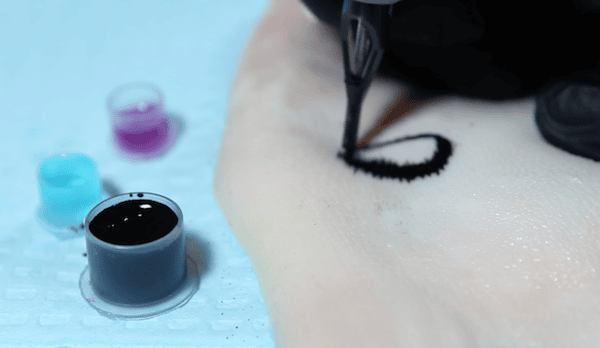
[Image above] Credit: MIT Media Lab
Tattoos—you either love ‘em or hate ‘em.
A recent Harris poll found that 29% of adults have at least one tattoo. And about a fourth (23%) of inked adults have regretted that decision.
But what if a tattoo could diagnose medical conditions? Would you change your mind about your tattoo if you knew it could monitor glucose levels or provide you with data on your cholesterol?
A recent collaboration between researchers at Massachusetts Institute of Technology and Harvard Medical School indicates that the future of medical diagnostics could be in your body art.
Their project, DermalAbyss, illustrates how the skin becomes an interactive surface that displays reactions to interstitial fluid variations with a tattoo ink containing biosensors. The researchers developed four color-changing biosensors—a sodium ion sensor, a pH sensor that fluoresces between purple and pink, a green to brown glucose sensor, and a second chromogenic pH sensor.
For example, the ink’s color indicates the status of glucose levels, allowing diabetics to monitor their levels by reading the tattoo instead of the traditional method of pricking their skin.

Credit: MIT Media Lab
In a proof-of-concept study, the team conducted research on pig skin, accessing different compartments of the body to identify inner metabolic processes that could be “read” through the tattoo.
“It could be used for applications in continuously monitoring, such as medical diagnostics, quantified self, and data encoding in the body,” according to an MIT video.
“In the same way that the wearables industry is integrating fashion practices into their development, we envision new participation between the biotech companies and skin professionals, such as prosthesis experts and tattooists, in order to embrace the idea of human device symbiosis,” one of the researchers mentions in the video.
The next phase of their research will focus on improving sensor performance, safety, long-term retention in the skin, and tattoo location in relation to specific health issues.
The paper, “The Dermal Abyss: Interfacing with the Skin by Tattooing Biosensors,” will be presented at the 2017 ACM International Symposium on Wearable Computers.
Watch the video below to learn more.
Credit: Fluid Interfaces; Vimeo
DermalAbyss: Possibilities of Biosensors as a Tattooed Interface from Fluid Interfaces on Vimeo.
Author
Faye Oney
CTT Categories
- Biomaterials & Medical
- Material Innovations


